外研版(2019)选择性必修第二册 Unit6 Survival Starting out and Understanding ideas 名师教学设计
文档属性
| 名称 | 外研版(2019)选择性必修第二册 Unit6 Survival Starting out and Understanding ideas 名师教学设计 | 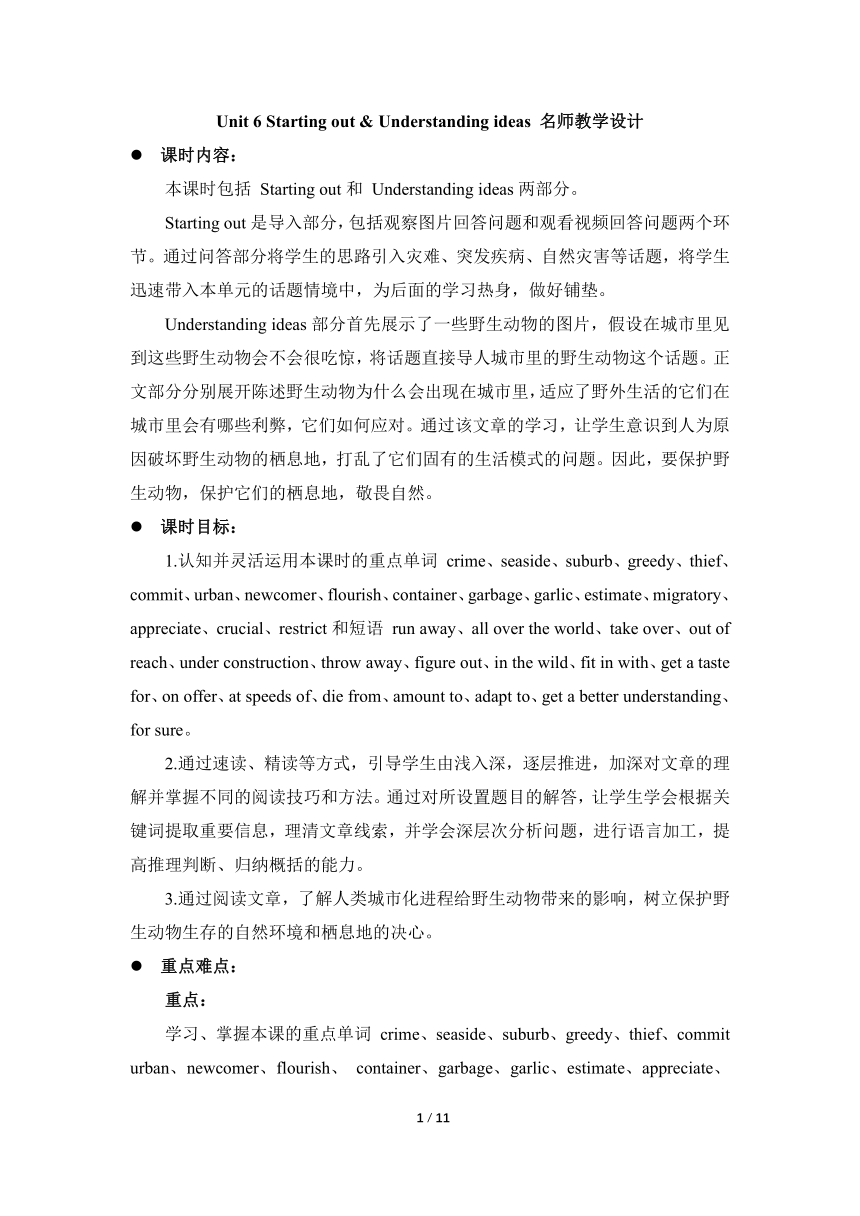 | |
| 格式 | docx | ||
| 文件大小 | 5.1MB | ||
| 资源类型 | 教案 | ||
| 版本资源 | 外研版(2019) | ||
| 科目 | 英语 | ||
| 更新时间 | 2023-03-04 09:28:35 | ||
图片预览

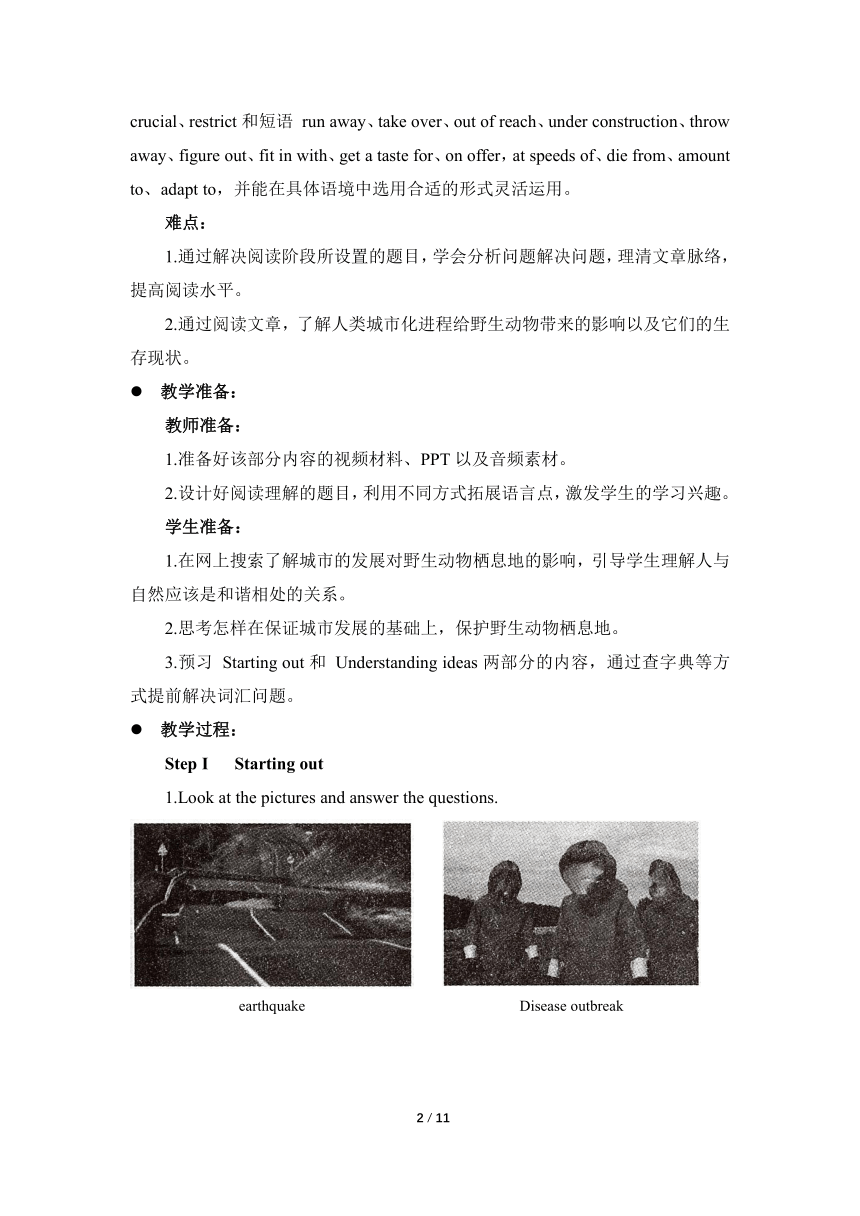
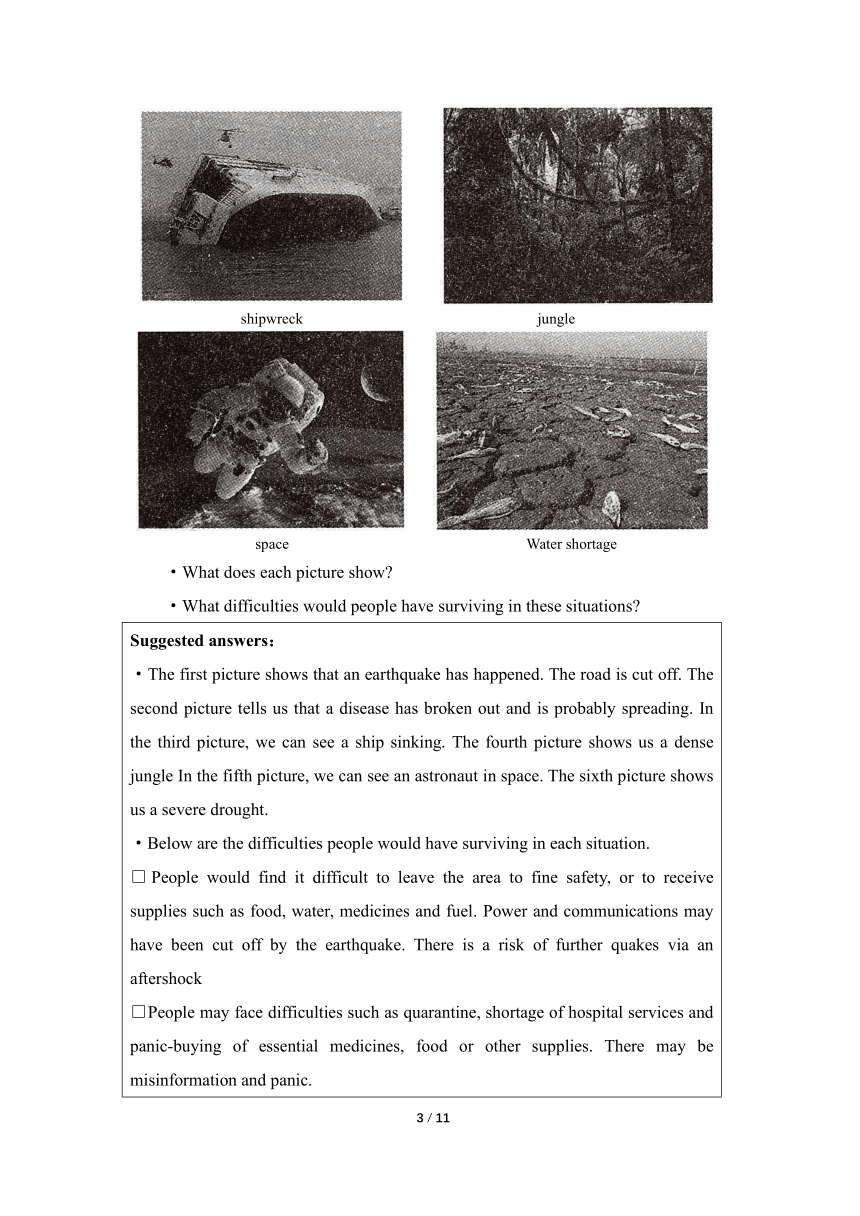
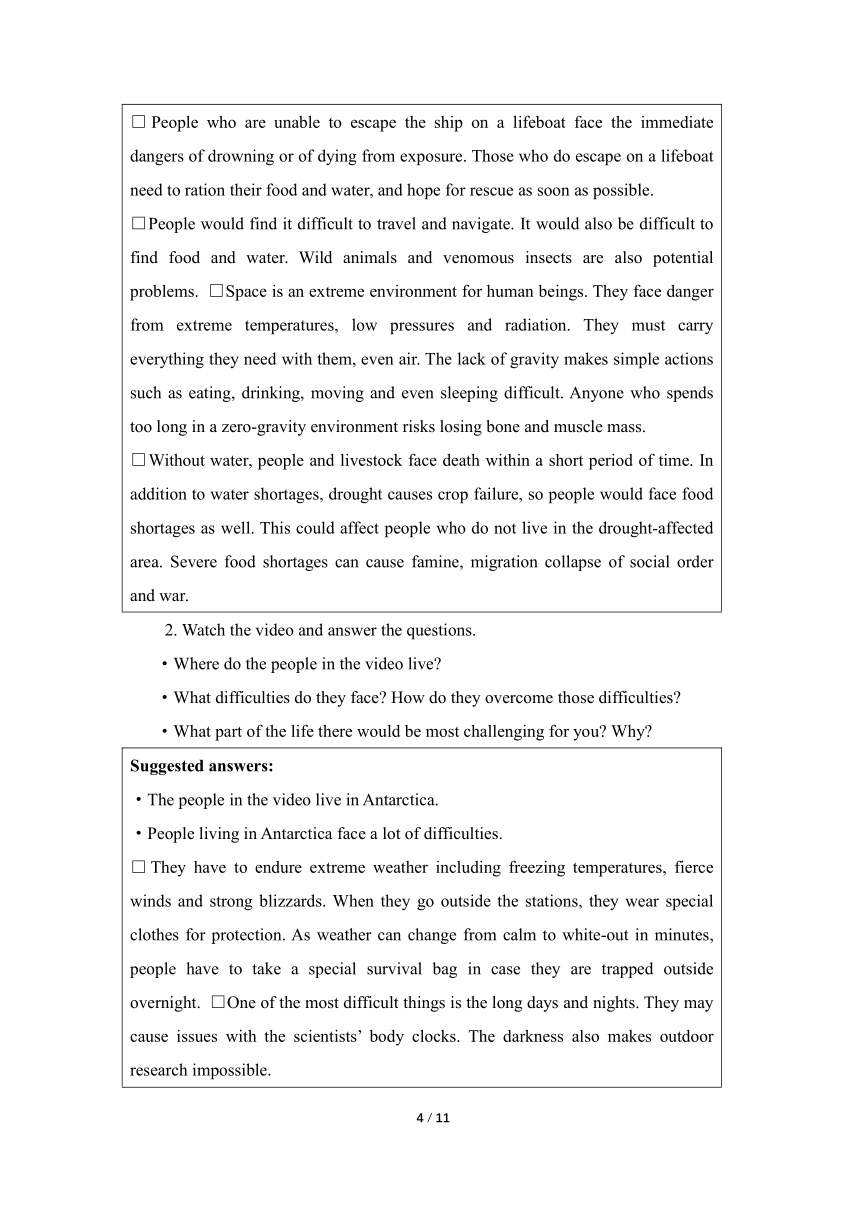
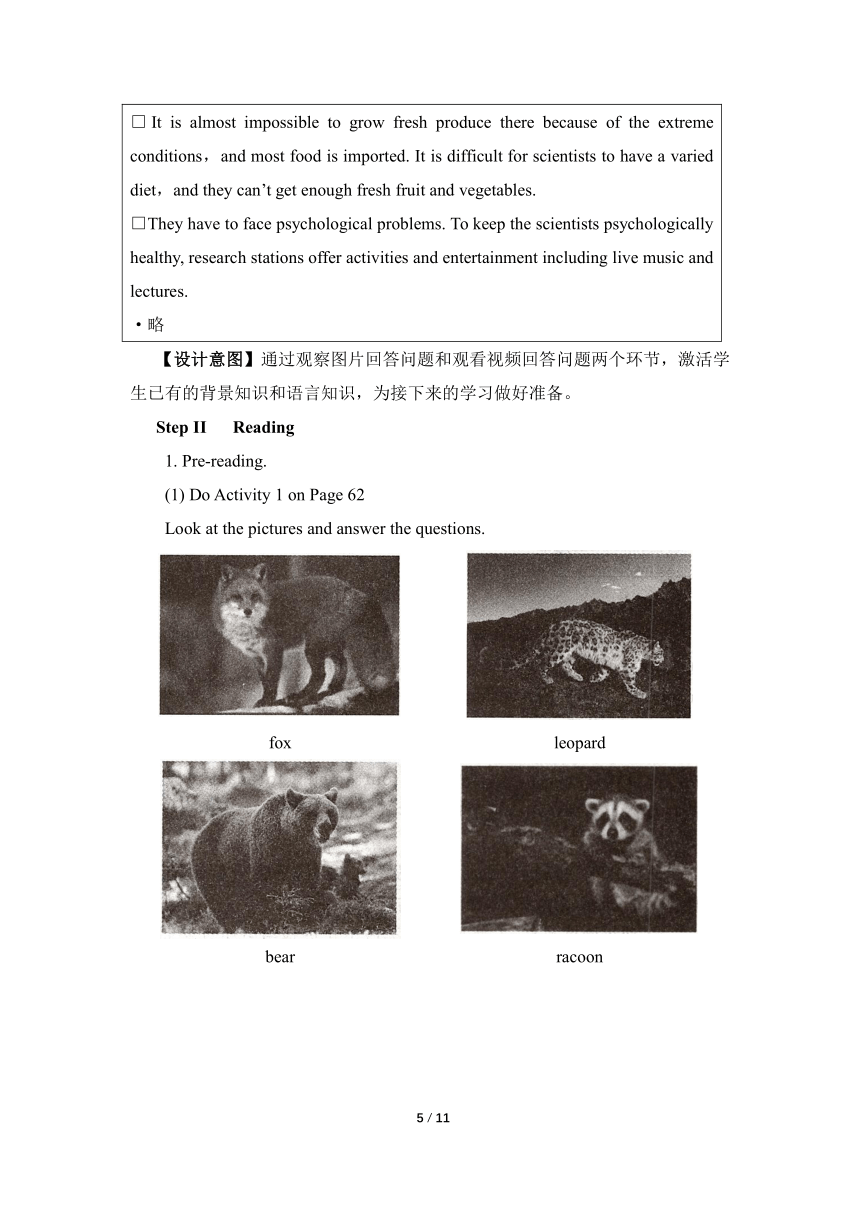
文档简介
Unit 6 Starting out & Understanding ideas 名师教学设计
课时内容:
本课时包括 Starting out和 Understanding ideas两部分。
Starting out是导入部分,包括观察图片回答问题和观看视频回答问题两个环节。通过问答部分将学生的思路引入灾难、突发疾病、自然灾害等话题,将学生迅速带入本单元的话题情境中,为后面的学习热身,做好铺垫。
Understanding ideas部分首先展示了一些野生动物的图片,假设在城市里见到这些野生动物会不会很吃惊,将话题直接导人城市里的野生动物这个话题。正文部分分别展开陈述野生动物为什么会出现在城市里,适应了野外生活的它们在城市里会有哪些利弊,它们如何应对。通过该文章的学习,让学生意识到人为原因破坏野生动物的栖息地,打乱了它们固有的生活模式的问题。因此,要保护野生动物,保护它们的栖息地,敬畏自然。
课时目标:
1.认知并灵活运用本课时的重点单词 crime、seaside、suburb、greedy、thief、commit、urban、newcomer、flourish、container、garbage、garlic、estimate、migratory、appreciate、crucial、restrict和短语 run away、all over the world、take over、out of reach、under construction、throw away、figure out、in the wild、fit in with、get a taste for、on offer、at speeds of、die from、amount to、adapt to、get a better understanding、for sure。
2.通过速读、精读等方式,引导学生由浅入深,逐层推进,加深对文章的理解并掌握不同的阅读技巧和方法。通过对所设置题目的解答,让学生学会根据关键词提取重要信息,理清文章线索,并学会深层次分析问题,进行语言加工,提高推理判断、归纳概括的能力。
3.通过阅读文章,了解人类城市化进程给野生动物带来的影响,树立保护野生动物生存的自然环境和栖息地的决心。
重点难点:
重点:
学习、掌握本课的重点单词 crime、seaside、suburb、greedy、thief、commit urban、newcomer、flourish、 container、garbage、garlic、estimate、appreciate、crucial、restrict和短语 run away、take over、out of reach、under construction、throw away、figure out、fit in with、get a taste for、on offer,at speeds of、die from、amount to、adapt to,并能在具体语境中选用合适的形式灵活运用。
难点:
1.通过解决阅读阶段所设置的题目,学会分析问题解决问题,理清文章脉络,提高阅读水平。
2.通过阅读文章,了解人类城市化进程给野生动物带来的影响以及它们的生存现状。
教学准备:
教师准备:
1.准备好该部分内容的视频材料、PPT以及音频素材。
2.设计好阅读理解的题目,利用不同方式拓展语言点,激发学生的学习兴趣。
学生准备:
1.在网上搜索了解城市的发展对野生动物栖息地的影响,引导学生理解人与自然应该是和谐相处的关系。
2.思考怎样在保证城市发展的基础上,保护野生动物栖息地。
3.预习 Starting out和 Understanding ideas两部分的内容,通过查字典等方式提前解决词汇问题。
教学过程:
Step I Starting out
1.Look at the pictures and answer the questions.
earthquake Disease outbreak
shipwreck jungle
space Water shortage
·What does each picture show
·What difficulties would people have surviving in these situations
Suggested answers: ·The first picture shows that an earthquake has happened. The road is cut off. The second picture tells us that a disease has broken out and is probably spreading. In the third picture, we can see a ship sinking. The fourth picture shows us a dense jungle In the fifth picture, we can see an astronaut in space. The sixth picture shows us a severe drought. ·Below are the difficulties people would have surviving in each situation. □People would find it difficult to leave the area to fine safety, or to receive supplies such as food, water, medicines and fuel. Power and communications may have been cut off by the earthquake. There is a risk of further quakes via an aftershock □People may face difficulties such as quarantine, shortage of hospital services and panic-buying of essential medicines, food or other supplies. There may be misinformation and panic. □People who are unable to escape the ship on a lifeboat face the immediate dangers of drowning or of dying from exposure. Those who do escape on a lifeboat need to ration their food and water, and hope for rescue as soon as possible. □People would find it difficult to travel and navigate. It would also be difficult to find food and water. Wild animals and venomous insects are also potential problems. □Space is an extreme environment for human beings. They face danger from extreme temperatures, low pressures and radiation. They must carry everything they need with them, even air. The lack of gravity makes simple actions such as eating, drinking, moving and even sleeping difficult. Anyone who spends too long in a zero-gravity environment risks losing bone and muscle mass. □Without water, people and livestock face death within a short period of time. In addition to water shortages, drought causes crop failure, so people would face food shortages as well. This could affect people who do not live in the drought-affected area. Severe food shortages can cause famine, migration collapse of social order and war.
2. Watch the video and answer the questions.
·Where do the people in the video live
·What difficulties do they face How do they overcome those difficulties
·What part of the life there would be most challenging for you Why
Suggested answers: ·The people in the video live in Antarctica. ·People living in Antarctica face a lot of difficulties. □They have to endure extreme weather including freezing temperatures, fierce winds and strong blizzards. When they go outside the stations, they wear special clothes for protection. As weather can change from calm to white-out in minutes, people have to take a special survival bag in case they are trapped outside overnight. □One of the most difficult things is the long days and nights. They may cause issues with the scientists’ body clocks. The darkness also makes outdoor research impossible. □It is almost impossible to grow fresh produce there because of the extreme conditions,and most food is imported. It is difficult for scientists to have a varied diet,and they can’t get enough fresh fruit and vegetables. □They have to face psychological problems. To keep the scientists psychologically healthy, research stations offer activities and entertainment including live music and lectures. ·略
【设计意图】通过观察图片回答问题和观看视频回答问题两个环节,激活学生已有的背景知识和语言知识,为接下来的学习做好准备。
Step II Reading
1. Pre-reading.
(1) Do Activity 1 on Page 62
Look at the pictures and answer the questions.
fox leopard
bear racoon
chacma baboon hedgehog
·Where would you normally expect to find these animals
·Would you be surprised to see these animals in a city Why or why not
·What problems could they encounter in cities
Suggested answers: ·In the wild. ·(略) ·They may have difficulties finding food,shelter and mates. If people find them,they may be trapped or killed.
(2) Do Activity 2 on Page 62.
Look at the title of the passage and the picture Think about what the title means.
Suggested answer: The title means the wild animals within the cities.
【设计意图】通过看图片回答问题和思考标题的含义,引导学生充分利用已知信息,培养推理判断能力。
2. Fast reading.
Read the passage and then match the main ideas with the related paragraphs.
Para.1:_____________________________________
Para.2:_____________________________________
Para.3:_____________________________________
Para.4:_____________________________________
Para.5:_____________________________________
Para.6:_____________________________________
A. The benefits that a city can offer to these newcomers. B. More and more wild animals are entering our cities. C. Wild animals' ability to adapt themselves to the city life. D. We should get a better understanding of these wild animals. E. The reason behind this mass urban migration. F. Dangers for some animals that cant adapt.
Suggested answers: Para 1-B; Para. 2-E; Para 3-A; Para. 4-C; Para. 5-F; Para. 6-D;
【设计意图】通过段意匹配题,引导学生概括段意,了解文章结构,提高学生的阅读理解能力和概括归纳能力。
3.Careful reading.
(1)Read the passage again and choose the best answers.
①How many kinds of wild animals are mentioned in the passage A.2. B.3. C.4. D.5 ②What did most people think pushed these animals into the city? A. We human beings. B. The destroy of nature. C. The change of their living habits. D. Urban development and climate change. ③What does the word "they" in the first sentence of the third paragraph refer to? A. Our cities. B. New habitats. C. These animals. D. Appealing spaces. ④What should we do to achieve a balance between urban development and the protection of wild animals A. Drive these animals out of our cities. B. Understand better and appreciate them. C. Offer what we can to these wild animals. D. Try our best to protect these wild animals.
Suggested answers: C ②D ③A ④B
(2)Language points.
Master the words and phrases:
crime,seaside,suburb,greedy,thief,commit,urban,newcomer,flourish,container,garbage,garlic estimate,appreciate,crucial,restrict,run away,take over,out of reach,under construction,throw away,figure out,fit in with,get a taste for,on offer,at speeds of,die from,amount to,adapt to
【备注】词汇知识点讲解详见第二教案“新知探究”。
(3)Read the passage again and retell it.
【设计意图】通过设置一系列活动,进一步归纳、概括文章,理清文章脉络,有助于学生更好地加深对文章的理解。同时,在读懂语篇的基础上,将英语句法、词汇的知识融合在一起,更科学地反映学生的口头表达能力和英语综合能力。
4. Post-reading.
(1) Do activity 3 on Page 64.
Choose the topic sentences for Paragraphs 2-5 and write them on the lines to complete the passage.
Para. 2:______________________________________________________
Para. 3:______________________________________________________
Para. 4:______________________________________________________
Para. 5:______________________________________________________
A One thing crucial to the increasing number of “urban animals”is their ability to adapt. B People often wonder about the reasons behind this mass urban migration. C For those animals that don’t adapt, the city can be a dangerous or even deadly place. D Yet, for its newest and wildest inhabitants, a city can offer many benefits.
Suggested answers: Para 2-B; Para. 3-D; Para. 4-A; Para. 5-C;
【设计意图】该活动要求选择第二到第五自然段的主题句,检验学生对文章段意的把握。同时,锻炼了学生归纳问题的能力。
(2)Do Activity 4 on Page 64.
Organise information from the passage and complete the diagram.
Suggested answers: ①out of their natural habitats ②Wherever they go, animals find towns and cities in their way. With nowhere else to make their homes they have no choice but to move in with us. ③Out of reach from many of their natural predators these newcomers often flourish in their new city lives. ④Hungry animals are finding plenty to eat in our gardens and in the leftovers we throw away. ⑤Intelligent than their wild cousins ⑥Some animals have even changed their living habits to fit in with their new homes. ⑦Some birds crash into windows because they areunable to distinguish between blue sky and glass. ⑧Some birds have yet to change their migratory routes that take them through cities with high-rise buildings. ⑨look towards harmoniously sharing our urban habitats.
【设计意图】该活动通过思维导图的形式,列举了野生动物迁移到城市的原因、益处、适应以及危险,有助于学生理清文章主线、获取关键信息。引导学生抓住题目中的关键词,回扣原文,通过原文定位法,找到问题的答案。
Step Ⅲ Summing up
1.总结本节课的重点单词crime、seaside、suburb、greedy、thief、commit、urban、newcomer、flourish、container、garbage、garlic、estimate、appreciate、crucial、restrict和短语run away、take over、out of reach、under construction、throw away、figure out、fit in with、get a taste for、on offer、at speeds of、die from、amount to、adapt to及句型,采用表格、思维导图等形式更清晰地了解它们的用法,形成知识脉络。
2.让学生用英语简短地陈述野生动物迁移到城市的原因、益处、适应以及危险,进一步锻炼学生概括、归纳的能力。
3.随着城市建设的加快,我们更应该重视野生动物问题,在城市建设的时候不要只想着建设发展我们自己的家园,也应该为那些野生动物考虑。建设我们自己家园的时候不要去破坏野生动物的家园,让我们能共同生活在这个美丽的地球上。
Step IV Homework
1. Sum up what we learnt in class and take notes.
2. Preview the next period.
板书设计
Unit 6 Survival Period I Starting out & Understanding ideas I. Starting out 1. Look at the pictures and answer the questions. 2. Watch the video and answer the questions Ⅱ. Reading Pre-reading (1) Do Activity 1 on Page 62. Look at the pictures and answer the questions. (2) Do activity 2 on Page 62. Look at the title of the passage and the picture. Think about what the title means 2. Fast reading Read the passage and then match the main ideas with the related paragraphs. 3. Careful reading (1) Read the passage again and choose the best answers. (2) Language points. Master the words and phrases: crime, seaside, suburb, greedy, thief, commit, urban, newcomer, flourish, container, garbage, garlic, estimate, appreciate, crucial, restrict, run away, take over, out of reach, under construction, throw away, figure out, fit in with, get a taste for, on offer, at speeds of, die from, amount to, adapt to (3) Read the passage again and retell it. 4. Post-reading. (1) Do Activity 3 on Page 64. Choose the topic sentences for Paragraphs 2~5 and write them on the lines to complete the passage. (2) Do Activity 4 on Page 64. Organise information from the passage and complete the diagram. Ⅲ. Summing up Ⅳ. Homework
2 / 2
课时内容:
本课时包括 Starting out和 Understanding ideas两部分。
Starting out是导入部分,包括观察图片回答问题和观看视频回答问题两个环节。通过问答部分将学生的思路引入灾难、突发疾病、自然灾害等话题,将学生迅速带入本单元的话题情境中,为后面的学习热身,做好铺垫。
Understanding ideas部分首先展示了一些野生动物的图片,假设在城市里见到这些野生动物会不会很吃惊,将话题直接导人城市里的野生动物这个话题。正文部分分别展开陈述野生动物为什么会出现在城市里,适应了野外生活的它们在城市里会有哪些利弊,它们如何应对。通过该文章的学习,让学生意识到人为原因破坏野生动物的栖息地,打乱了它们固有的生活模式的问题。因此,要保护野生动物,保护它们的栖息地,敬畏自然。
课时目标:
1.认知并灵活运用本课时的重点单词 crime、seaside、suburb、greedy、thief、commit、urban、newcomer、flourish、container、garbage、garlic、estimate、migratory、appreciate、crucial、restrict和短语 run away、all over the world、take over、out of reach、under construction、throw away、figure out、in the wild、fit in with、get a taste for、on offer、at speeds of、die from、amount to、adapt to、get a better understanding、for sure。
2.通过速读、精读等方式,引导学生由浅入深,逐层推进,加深对文章的理解并掌握不同的阅读技巧和方法。通过对所设置题目的解答,让学生学会根据关键词提取重要信息,理清文章线索,并学会深层次分析问题,进行语言加工,提高推理判断、归纳概括的能力。
3.通过阅读文章,了解人类城市化进程给野生动物带来的影响,树立保护野生动物生存的自然环境和栖息地的决心。
重点难点:
重点:
学习、掌握本课的重点单词 crime、seaside、suburb、greedy、thief、commit urban、newcomer、flourish、 container、garbage、garlic、estimate、appreciate、crucial、restrict和短语 run away、take over、out of reach、under construction、throw away、figure out、fit in with、get a taste for、on offer,at speeds of、die from、amount to、adapt to,并能在具体语境中选用合适的形式灵活运用。
难点:
1.通过解决阅读阶段所设置的题目,学会分析问题解决问题,理清文章脉络,提高阅读水平。
2.通过阅读文章,了解人类城市化进程给野生动物带来的影响以及它们的生存现状。
教学准备:
教师准备:
1.准备好该部分内容的视频材料、PPT以及音频素材。
2.设计好阅读理解的题目,利用不同方式拓展语言点,激发学生的学习兴趣。
学生准备:
1.在网上搜索了解城市的发展对野生动物栖息地的影响,引导学生理解人与自然应该是和谐相处的关系。
2.思考怎样在保证城市发展的基础上,保护野生动物栖息地。
3.预习 Starting out和 Understanding ideas两部分的内容,通过查字典等方式提前解决词汇问题。
教学过程:
Step I Starting out
1.Look at the pictures and answer the questions.
earthquake Disease outbreak
shipwreck jungle
space Water shortage
·What does each picture show
·What difficulties would people have surviving in these situations
Suggested answers: ·The first picture shows that an earthquake has happened. The road is cut off. The second picture tells us that a disease has broken out and is probably spreading. In the third picture, we can see a ship sinking. The fourth picture shows us a dense jungle In the fifth picture, we can see an astronaut in space. The sixth picture shows us a severe drought. ·Below are the difficulties people would have surviving in each situation. □People would find it difficult to leave the area to fine safety, or to receive supplies such as food, water, medicines and fuel. Power and communications may have been cut off by the earthquake. There is a risk of further quakes via an aftershock □People may face difficulties such as quarantine, shortage of hospital services and panic-buying of essential medicines, food or other supplies. There may be misinformation and panic. □People who are unable to escape the ship on a lifeboat face the immediate dangers of drowning or of dying from exposure. Those who do escape on a lifeboat need to ration their food and water, and hope for rescue as soon as possible. □People would find it difficult to travel and navigate. It would also be difficult to find food and water. Wild animals and venomous insects are also potential problems. □Space is an extreme environment for human beings. They face danger from extreme temperatures, low pressures and radiation. They must carry everything they need with them, even air. The lack of gravity makes simple actions such as eating, drinking, moving and even sleeping difficult. Anyone who spends too long in a zero-gravity environment risks losing bone and muscle mass. □Without water, people and livestock face death within a short period of time. In addition to water shortages, drought causes crop failure, so people would face food shortages as well. This could affect people who do not live in the drought-affected area. Severe food shortages can cause famine, migration collapse of social order and war.
2. Watch the video and answer the questions.
·Where do the people in the video live
·What difficulties do they face How do they overcome those difficulties
·What part of the life there would be most challenging for you Why
Suggested answers: ·The people in the video live in Antarctica. ·People living in Antarctica face a lot of difficulties. □They have to endure extreme weather including freezing temperatures, fierce winds and strong blizzards. When they go outside the stations, they wear special clothes for protection. As weather can change from calm to white-out in minutes, people have to take a special survival bag in case they are trapped outside overnight. □One of the most difficult things is the long days and nights. They may cause issues with the scientists’ body clocks. The darkness also makes outdoor research impossible. □It is almost impossible to grow fresh produce there because of the extreme conditions,and most food is imported. It is difficult for scientists to have a varied diet,and they can’t get enough fresh fruit and vegetables. □They have to face psychological problems. To keep the scientists psychologically healthy, research stations offer activities and entertainment including live music and lectures. ·略
【设计意图】通过观察图片回答问题和观看视频回答问题两个环节,激活学生已有的背景知识和语言知识,为接下来的学习做好准备。
Step II Reading
1. Pre-reading.
(1) Do Activity 1 on Page 62
Look at the pictures and answer the questions.
fox leopard
bear racoon
chacma baboon hedgehog
·Where would you normally expect to find these animals
·Would you be surprised to see these animals in a city Why or why not
·What problems could they encounter in cities
Suggested answers: ·In the wild. ·(略) ·They may have difficulties finding food,shelter and mates. If people find them,they may be trapped or killed.
(2) Do Activity 2 on Page 62.
Look at the title of the passage and the picture Think about what the title means.
Suggested answer: The title means the wild animals within the cities.
【设计意图】通过看图片回答问题和思考标题的含义,引导学生充分利用已知信息,培养推理判断能力。
2. Fast reading.
Read the passage and then match the main ideas with the related paragraphs.
Para.1:_____________________________________
Para.2:_____________________________________
Para.3:_____________________________________
Para.4:_____________________________________
Para.5:_____________________________________
Para.6:_____________________________________
A. The benefits that a city can offer to these newcomers. B. More and more wild animals are entering our cities. C. Wild animals' ability to adapt themselves to the city life. D. We should get a better understanding of these wild animals. E. The reason behind this mass urban migration. F. Dangers for some animals that cant adapt.
Suggested answers: Para 1-B; Para. 2-E; Para 3-A; Para. 4-C; Para. 5-F; Para. 6-D;
【设计意图】通过段意匹配题,引导学生概括段意,了解文章结构,提高学生的阅读理解能力和概括归纳能力。
3.Careful reading.
(1)Read the passage again and choose the best answers.
①How many kinds of wild animals are mentioned in the passage A.2. B.3. C.4. D.5 ②What did most people think pushed these animals into the city? A. We human beings. B. The destroy of nature. C. The change of their living habits. D. Urban development and climate change. ③What does the word "they" in the first sentence of the third paragraph refer to? A. Our cities. B. New habitats. C. These animals. D. Appealing spaces. ④What should we do to achieve a balance between urban development and the protection of wild animals A. Drive these animals out of our cities. B. Understand better and appreciate them. C. Offer what we can to these wild animals. D. Try our best to protect these wild animals.
Suggested answers: C ②D ③A ④B
(2)Language points.
Master the words and phrases:
crime,seaside,suburb,greedy,thief,commit,urban,newcomer,flourish,container,garbage,garlic estimate,appreciate,crucial,restrict,run away,take over,out of reach,under construction,throw away,figure out,fit in with,get a taste for,on offer,at speeds of,die from,amount to,adapt to
【备注】词汇知识点讲解详见第二教案“新知探究”。
(3)Read the passage again and retell it.
【设计意图】通过设置一系列活动,进一步归纳、概括文章,理清文章脉络,有助于学生更好地加深对文章的理解。同时,在读懂语篇的基础上,将英语句法、词汇的知识融合在一起,更科学地反映学生的口头表达能力和英语综合能力。
4. Post-reading.
(1) Do activity 3 on Page 64.
Choose the topic sentences for Paragraphs 2-5 and write them on the lines to complete the passage.
Para. 2:______________________________________________________
Para. 3:______________________________________________________
Para. 4:______________________________________________________
Para. 5:______________________________________________________
A One thing crucial to the increasing number of “urban animals”is their ability to adapt. B People often wonder about the reasons behind this mass urban migration. C For those animals that don’t adapt, the city can be a dangerous or even deadly place. D Yet, for its newest and wildest inhabitants, a city can offer many benefits.
Suggested answers: Para 2-B; Para. 3-D; Para. 4-A; Para. 5-C;
【设计意图】该活动要求选择第二到第五自然段的主题句,检验学生对文章段意的把握。同时,锻炼了学生归纳问题的能力。
(2)Do Activity 4 on Page 64.
Organise information from the passage and complete the diagram.
Suggested answers: ①out of their natural habitats ②Wherever they go, animals find towns and cities in their way. With nowhere else to make their homes they have no choice but to move in with us. ③Out of reach from many of their natural predators these newcomers often flourish in their new city lives. ④Hungry animals are finding plenty to eat in our gardens and in the leftovers we throw away. ⑤Intelligent than their wild cousins ⑥Some animals have even changed their living habits to fit in with their new homes. ⑦Some birds crash into windows because they areunable to distinguish between blue sky and glass. ⑧Some birds have yet to change their migratory routes that take them through cities with high-rise buildings. ⑨look towards harmoniously sharing our urban habitats.
【设计意图】该活动通过思维导图的形式,列举了野生动物迁移到城市的原因、益处、适应以及危险,有助于学生理清文章主线、获取关键信息。引导学生抓住题目中的关键词,回扣原文,通过原文定位法,找到问题的答案。
Step Ⅲ Summing up
1.总结本节课的重点单词crime、seaside、suburb、greedy、thief、commit、urban、newcomer、flourish、container、garbage、garlic、estimate、appreciate、crucial、restrict和短语run away、take over、out of reach、under construction、throw away、figure out、fit in with、get a taste for、on offer、at speeds of、die from、amount to、adapt to及句型,采用表格、思维导图等形式更清晰地了解它们的用法,形成知识脉络。
2.让学生用英语简短地陈述野生动物迁移到城市的原因、益处、适应以及危险,进一步锻炼学生概括、归纳的能力。
3.随着城市建设的加快,我们更应该重视野生动物问题,在城市建设的时候不要只想着建设发展我们自己的家园,也应该为那些野生动物考虑。建设我们自己家园的时候不要去破坏野生动物的家园,让我们能共同生活在这个美丽的地球上。
Step IV Homework
1. Sum up what we learnt in class and take notes.
2. Preview the next period.
板书设计
Unit 6 Survival Period I Starting out & Understanding ideas I. Starting out 1. Look at the pictures and answer the questions. 2. Watch the video and answer the questions Ⅱ. Reading Pre-reading (1) Do Activity 1 on Page 62. Look at the pictures and answer the questions. (2) Do activity 2 on Page 62. Look at the title of the passage and the picture. Think about what the title means 2. Fast reading Read the passage and then match the main ideas with the related paragraphs. 3. Careful reading (1) Read the passage again and choose the best answers. (2) Language points. Master the words and phrases: crime, seaside, suburb, greedy, thief, commit, urban, newcomer, flourish, container, garbage, garlic, estimate, appreciate, crucial, restrict, run away, take over, out of reach, under construction, throw away, figure out, fit in with, get a taste for, on offer, at speeds of, die from, amount to, adapt to (3) Read the passage again and retell it. 4. Post-reading. (1) Do Activity 3 on Page 64. Choose the topic sentences for Paragraphs 2~5 and write them on the lines to complete the passage. (2) Do Activity 4 on Page 64. Organise information from the passage and complete the diagram. Ⅲ. Summing up Ⅳ. Homework
2 / 2
